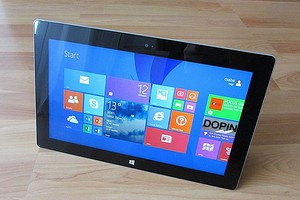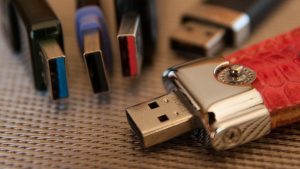- Running Linux on Windows Tablet
- Background
- The Idea
- My Usage
- My Problem with Windows
- Doing the groundwork
- Distro Hopping
- Linux Mint
- Zorin OS
- Elementary OS
- Fedora
- Lubuntu — My final savior
- The Verdict
- Устанавливаем Linux на Windows-планшет
- Linux на планшете с Windows 8: подготавливаем загрузочный носитель
- Windows-планшет: загружаемся с USB-флешки
- Устанавливаем Linux на планшет
Running Linux on Windows Tablet
In this blog I will be narrating my experience of how my search for running Linux on my Acer One 10 Windows Tablet ended. And key take aways from my experince. And yes I am writing this blog on my Acer tablet using Linux OS,now please wait till the end to find the Distro I am using.
Background
Yesterday my assembled PC which ran Zorin OS (A very user friendly Ubuntu based Distro) stopped working. Now I was in middle of downloading a bunch of light weight Linux ISO when this happened.My original plan was to download them burn them to a CD and test them on my PC. For a better part of 3-4 months this PC has been my companion for using Linux and developing my personal Projects. After many hit and trail I found Zorin OS perfect for my Pentium based PC. Now the PCs or Laptops that I have are not so much powerful and neither I want to add the bloat of Windows to it. Despite the fact that my PC has a old Windows 7 OS, thanks to my family downloading unknown software, the OS was virus infested and crashed the moment it boots. This left me with very few options, either use Linux on a VM or use my Raspberry Pi 4. And that when I thought about running Linux on my Acer One 10 tablet.
The Idea
Now the idea of running Linux on my Acer One 10 Tablet was not new, I have been exploring this option for last few months. I have been exploring many forums and was trying to understand how can I run Linux on my humble 2-1 Intel Atom tablet. Now let me get the specs of the tablet out of the way so that you can understand how much low spec this Tablet is and the challenges of running Linux on it.
Model: Acer One 10 SW110-1CT Memory: 2GB CPU: Intel(R) Atom(TM) x5-Z8350 CPU @ 1.44GHz Onboard Storage: eMMC 32GB storage Cherry on the topping is it uses UEFI for boot and while the UEFI is 32 bit, the OS architecture that it runs is 64-bit. Now this problem is not just of this tablet but of many 2-in-1 Windows tablet based on this Intel Atom processor.
My Usage
The primary use of such tablets based on my experience is light surfing, light editing and as a travel companion. With just being 11 Inch and such a small and light form factor, it was very easy for me to take this tablet while traveling and to meetings as it was not as heavy as a full 15 inch laptop and also with some light weight Code editors like Notepad++ and even VSCode I was able to get some of coding done. I even was able to install Python 3.7 on it and run some of my Python scripts.
My Problem with Windows
While the OEM version of Windows 8.1 ran well for almost a year without any issues, but since last few months, as I started doing some serious coding and blogging I found the Windows OS bloaty and also despite the touch screen and the Tablet feature, the reason I bought this 2 in 1 was to use its Laptop feature which was becoming more and more difficult with the continuous updates to the OS and the dwindling size of the 32GB eMMC storage which was more and more taken up by the Windows OS and its patches. And with every update the Tablet became more slower and with lesser storage making the Tablet of no value for which I bought it. Also I did more coding on this, I missed the bash shell more as I installed developer tools like Git and VSCode, it became more difficult to run them with such small disk space. This made me wonder what would it be like running Linux on such a system.
Doing the groundwork
Before even I can think of such an experiment I had to be clear that such a process was possible and as a start i just wanted to see if I can even run Linux on my Tablet. One of the most useful posts that I read during my research was on Reddit and this was pretty much what I used as the basis of my future work. I am putting the link below.
https://www.reddit.com/r/linuxhardware/comments/8azizs/running_ubuntu_on_the_terrible_acer_one_10_s1003/ To state the obvious, while the Acer Tablet was less that 200USD when I bought but when I started using for some coding, I realized how it was not such a great (terrible) idea. I would say if you really want to buy a light weight laptop which is portable and also usable then please search for something more powerful in 13 Inch form factor with usable keyboard and definitely not an Intel Atom processor and eMMC storage. Since I have one of these low power Intel Atom Tablets, it was better off exploring Linux then seeing it slowly dying with Windows. The most important part I took from the post was to check how to boot a linux 64 bit ISO to a 32 bit UEFI. And the trick for this was to use bootia32.efi given in the below Github link.
https://github.com/hirotakaster/baytail-bootia32.efi
Distro Hopping
While the writer in the reddit post had used Ubuntu in the earlier instance, my experience told given how Ubuntu is bleeding edge and how updates always broke the system and from my PC build experience where many of the native HW components (Wifi, Display, Audio) were not working out of the box, hence I chose to start from another distro which would be light weight and more stable.
Linux Mint
First I tried with Linux Mint, this Distro like many other distro did not come with bootia32.efi . Hence after downloading the efi file and the OS ISO image, I used Rufus to unpack the 64 bit ISO to a Fat32 formatted 8GB USB thumb drive. Then I searched for EFI/boot directory under the root filesystem of the distro and copied the efi file there. And tried booting, Now I am not sure for which reason, but when ever I tried booting the ISO, after the Grub screen it gave a very hazy display and then booted Linux in vertical alignment. After booting I had to go to Display settings to rotate it to align it in the right direction. This is something I had to do with many distros derived from Ubuntu.
With the hazy screen which went blank continuously the whole experience was unusable and hence I had to check out for other distros.
Zorin OS
As I had used Zorin as my main Distro for almost few months on my PC and I really like this distribution. For starters this distro has support for many types of hardware out of the box and it is able to pack a very lovely and clean display which makes me remind of Windows 10, in some ways I liked the stock Zorin Desktop over Windows 8 or 10. As expected once I set my USB with the Zorin 15 Core 64 bit ISO, and copied the bootia32.efi file, the OS booted to live Zorin OS session without much issues. While initially I was able to do some work with the distro and was about to install the OS on my Laptop, the unexpected Freezing of the screen happened. And this got repeated many times as I rebooted the Tablet. Given the small 8GB USB drive and the small 2Gb ram and the low powered Atom processor, made the whole tablet unusable and it kept on either freezing or the display switched off. Hence this version of Zorin was out of the race. I even tried installing Zorin light 12.4 64 bit ISO, but that even refused to boot beyond the grub screen. I am waiting for Zorin Lite 15 64 bit ISO, so that it is usable on my laptop.
Elementary OS
While I was checking other ISOs to use, I remembered the Mac OS clone elementary OS and wanted to see how it works out. I went to their website, downloaded the elementary 5.0 64 bit ISO image and set it on the formatted USB drive and coped the efi file. Much like Zorin OS, it also booted without any fuss but the best part of the OS was that it automatically alignend to my Tablet without doing display rotation and for me it was one of the best OS Desktops with minimal desktop design and the custom epipany browser and Mac like file manager and «code» editor. The best part of the experience was when I went to their repo and found how all the components of their custom desktop were developed from scratch using Vala programming language. Am surely going to explore the language in future. As I was about to finalize this beautiful OS, the display started going on and off in few minutes which again made this OS unusable.
Fedora
From the reddit post mentioned earlier I learned that Fedora 31 version supported 32 bit EFI boot out of the box and as I set it up using Rufus indeed it has the bootia32.efi file and also booted without any issues. From all of the above Distros, till now Fedora was the most easiest OS to boot out of the box and also in my initial usage was working good. I tried both the KDE plasma and the Workstation based 64 bit ISOs and both worked well. But the reason I did not use it was because the at some points I found KDE plasma crashing and felt a bit buggy and when I tried installing a utility on the Fedora Workstation OS it almost froze. Again please note that all of these experience were while using the Live ISO out of the USB and this may change if we install it onto the PC. Hence this brought me back to square one to find a light weight distribution.
Lubuntu — My final savior
Now before talking about Lubuntu, I would like to point that I also tried LXDE, Peppermint OS and few other but all failed to even boot after the grub screen. Hence I had very few options but to try Lubuntu. Now this is not my first experience with Lubuntu, I had tried Lubuntu when I was building my PC and for some reason then I did not like the look and feel of its Desktop for my PC. But this time around when I installed Lubuntu 64 bit ISO on the USB drive and copied bootia32.efi, I got the best bootup flash screen so far and even better as I saw the Desktop, I was almost in love with the Windows 7 like familiar look. The ram usage on Lubuntu was only 500MB to 600MB out of the 2GB ram when booted and also had 1 GB of Swap which made this distro the best of the lot that I had tried so far. Unlike Zorin & elementary OS where audio did not work or unlike Fedora where the system froze when ever I tried installing a binary using the system package manager, in Lubuntu everything worked out of the box and even better I was able to install some binaries like Geany to try out some coding.
The Verdict
After exploring various Linux distributions and trying to make it work on my Tablet, I am sure of one thing, none of these distros are as optimized for the resource constrained low power Tablet as Acer One 10 as Windows is. But as general purpose operating system, as of my writing (Oct 2019) the driver support for these types of laptops has improved a lot but in most cases this also comes at a cost of performance. And yet I am very happy today as I am writing this blog on Linux, despite not being able to use the touchscreen and despite fearing the dreaded screen freeze, the familiar look of the bash terminal and the rawness and customization that Linux Desktop provides is unmatched. The tinkerer in me feels more at home in a Linux than Mac or Windows where everything is so same and to some extent though just works and familiar but so boring.
Устанавливаем Linux на Windows-планшет
В данной статье с практическими советами от Chip мы расскажем вам о том, как можно инсталлировать на вашем планшете помимо Windows 8 еще и Linux.
Linux на планшете с Windows 8: подготавливаем загрузочный носитель
Прежде, чем вы приступите к инсталляции Linux на ваш планшет, для начала необходимо будет подготовить загрузочный носитель, на котором будет сохранен дистрибутив операционной системы Linux.
- В первую очередь необходимо выяснить, какой «образ» необходим для вашего планшета. В этом примере используется Linux-дистрибутив, который называется «Ubuntu». При этом вы можете выбрать между 32-битным, 64-битным и ARM-вариантами. Как правило, в планшетах устанавливаются ARM-процессоры.
- Кроме того, необходимо скачать и установить программу Win32 Disk Imager.
- Также для инсталляции вам понадобится USB-флешка емкостью по меньшей мере 4 Гбайт. Для начала отформатируйте эту USB-флешку под систему FAT32 и затем запустите утилиту Win32 Disk Imager. В «Image File» выберите файл Ubuntu, который скачали ранее, а в «Device» выберите букву, соответствующую имени вашей USB-флешки. После всех этих действий нажмите на «Write».
Windows-планшет: загружаемся с USB-флешки
В качестве следующего шага вы должны позволить вашему планшету загрузиться с USB-флешки. Но заметим, что работает это не всегда так просто, как в случае с обычным персональным компьютером.
- Выключите ваш планшетный компьютер и вставьте флешку в USB-порт. Снова включите планшет. Теперь он должен автоматически загрузиться с USB-флешки.
- В том случае, если ваш планшет загрузился «обычным» образом, снова выключите его и нажмите одновременно кнопки питания и увеличения громкости звука, чтобы войти в UEFI (BIOS). Здесь теперь вы можете указать, что планшет должен загружаться с USB-флешки.
Устанавливаем Linux на планшет
Теперь совершенно привычным образом вы можете установить Linux на своем планшете. Тем не менее, если вы позже хотели бы использовать еще и Windows, вы должны обратить внимание на одну мелочь.
- Во время инсталляции выберите пункт «Установить Ubuntu рядом с Windows 8». После этого можно будет распределить флеш-память планшета между операционными системами. Позже вы сможете использовать ваш планшет как с Linux, так и с Windows.




